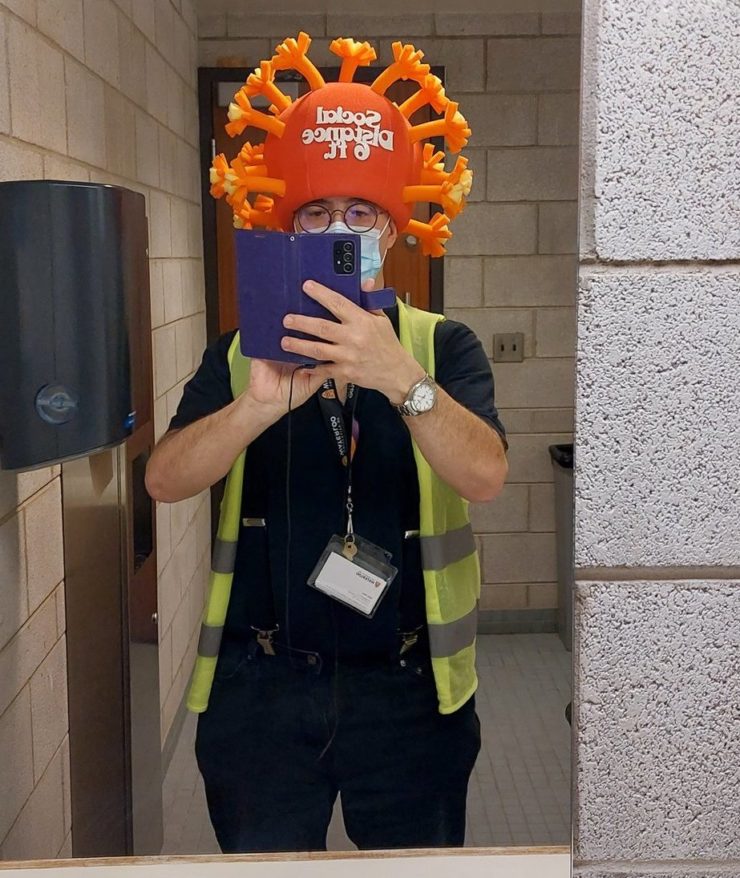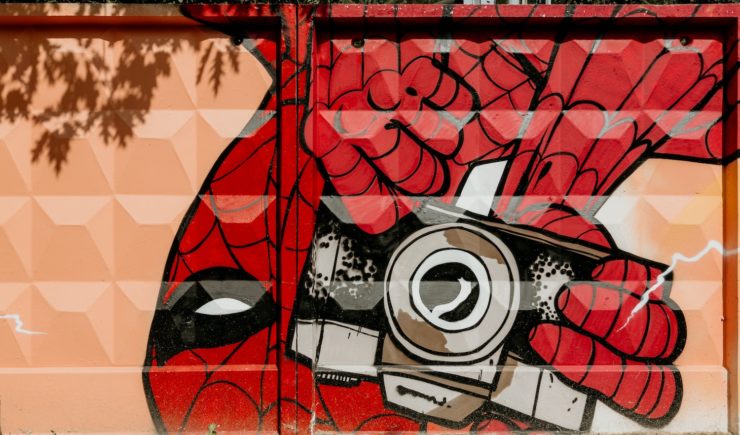When I was younger, I spent a fair amount of comic-reading time pondering questions like:
- How does Iron Man’s armor deal with the prodigious amount of heat it must generate?
- How is it that Batman always seems able to find a parking spot for the Batmobile?
- And—the actual subject of this essay—how it is that so many superheroes, dressed in garish eye-catching costumes, still seem to be able to sneak up on people at will?
I have come up with many possible explanations over the years but recent events have provided me with what I now think is the actual Watsonian answer.
What is this Watsonian view, you ask? TV Tropes explains all: when a creator answers a question about their work, should they provide an In-Universe answer or a Real Life answer? The former is the Watsonian perspective, the latter Doylist. That is, if you are bothered by something in the Sherlock Holmes canon, you can explain it as a hitherto unknown fact about the setting and characters (as Watson would do) or you can explain why the author, Conan Doyle, made the choice he did. Or made a mistake.
Before I reveal several possible Watsonian answers, I will first give you the Doylist answer to the question: how is it that superheroes in garish costumes can be sneaky?
The Doylist explanation is that superheroes wear colorful garb due to the limitations of early comics printing, as well as comic companies’ fondness for characters who were immediately recognizable and easily trademarked. The superheroes who are sneaky are sneaky because their creators said they were.
Buy the Book


Nona the Ninth
To be honest, once you grant premises like “became superfast because he got a transfusion of mongoose blood,” “can transfer his mind from android body to android body,” and “is a superpowered alien who nevertheless looks like a white American guy,” it’s hard to justify being skeptical about “is a bit sneaky.” Nevertheless, authorial fiat is a disappointing explanation.
A possible Watsonian answer might be that a lot of costumed characters spend their time lurking on rooftops. People for the most part do not look up. I’ve exploited this when working at theatres; I could monitor the audience for illicit food and drink from a conveniently elevated position, then relay the information to ushers on the main level.1 Astonishing as it may seem for a species whose ancestors may have been stalked by tree-branch-lurking great cats, humans focus on the horizontal to the near exclusion of the vertical. No audience member ever spotted me staring grimly down in quest of forbidden snackage.
Another, perhaps more convincing, Watsonian explanation might be that many superpowered characters have abilities that more than compensate for their eye-catching garb. The classic example is the Flash, whose bright red costume is more than made up for by his ability to go from over-the-horizon to in-your-face in an eye blink. Also he has a knack for vibrating such that he is invisible.
Another Watsonian possibility: the colorful costumes themselves are paradoxically stealthy. Perhaps they confuse the eye, making viewers think what they are looking at is farther away. Perhaps they are so bizarre, baffling and unexpected that they confound quick recognition.
This theory of concealment is no mere comic-fan hypothesis. It has had real-world proponents. Note such schemes as Dazzle Camouflage and Mountbatten Pink; consider Gerald H. Thayer’s remarkable Concealing-Coloration in the Animal Kingdom: An Exposition of the Laws of Disguise Through Color and Pattern; Being a Summary of Abbott H. Thayer’s Discoveries.
Unfortunately, experimental support for that idea is meager, but hey, so is evidence for people who can fly through sheer will alone.
However, recent experience as a mask-and-social distancing monitor (AKA space monitor) at a local university has revealed what I believe is a compelling, if disappointing, explanation. Note: space monitors do not get the jet pack and ray gun the title suggests.2 They get bright yellow vests. I’ve added a small embellishment. See if you can guess what it is.

Thanks to my theatre experience, I have developed many strategies for unexpected approaches. It turns out that, as space monitor, I need none of these. My largest challenge is getting people to notice me long enough for me to explain that masks are required on campus and how they are to be worn. I often have to plant myself directly in someone’s path before they see me.
The most likely Watsonian answer, as disappointing as it seems, is that a lot of humans are just incredibly comprehensively oblivious to their surroundings3, even those people who are not fixedly looking at their phones. Unexpected details in direct view do not startle because unexpected details are simply not noticed.
The real mystery may be how the superheroes get people to pay attention to them at all.
In the words of Wikipedia editor TexasAndroid, prolific book reviewer and perennial Darwin Award nominee James Davis Nicoll is of “questionable notability.” His work has appeared in Publishers Weekly and Romantic Times as well as on his own websites, James Nicoll Reviews and the Aurora finalist Young People Read Old SFF (where he is assisted by editor Karen Lofstrom and web person Adrienne L. Travis). He is a four-time finalist for the Best Fan Writer Hugo Award, is eligible to be nominated again this year, and is surprisingly flammable.
[1]I did ask for a zipline from the balcony or failing that, a tethered harpoon to retrieve the snacks, but was denied for reasons I do not have room to discuss.
[2]Trust me, I asked for the jet pack. Repeatedly. Or at least a space helmet.
[3]I am concerned when people reading their phones approach a particular three-riser staircase. But I must admit that I’ve never seen anyone stumble. I don’t know how they navigate something they don’t appear to be aware of, but they do so with aplomb.











How long will it be before even this alarmingly effective headgear becomes just another quotidian background element to be stepped around?
Douglas Adams said that a mountain-sized Somebody Else’s Problem field could be powered off of a 9V battery, so I imagine yours can be handled by heat scavenging.
I guess wearing an outlandish costume makes it all the easier for you to disappear afterwards? People are looking for some guy in blue leotards and a red cape, so nobody pays any attention to that dude in a suit wearing glasses….
By extension, it deflects attention away from what you really look like. People will remember what you’re wearing rather than what you actually looked like (obviously the mask is a big help).
So Robin wears bright colours so criminals will actually realize the Bat is around?
I don’t know if it’s a side-effect of growing up in the early internet days of aggressive pop-ups and screaming TV ads, but the harder something is trying to get my attention the more I tune it out.
It’s actually been problematic on occasion when I’ll miss obvious instructions or postings because they’ve highlighted the message and put it in bold red font.
My attention is like a non-Newtonian fluid, the slow knife pierces but a sledgehammer just hits with a *thwud*.
I saw the trailer for LOST CITY a few days ago. Sandra Bullock is wearing a hot pink evening gown covered in sequins, and she’s complaining about how the bad guys keep finding them. Channing Tatum deadpans, “You’re wearing a disco ball. What do you expect?”
Regarding people not seeing what they’re not looking for:
When I worked at a university help desk, people would often come in asking to use our stapler. For a while, we kept it on the external hard drive of one of the Macs, because it was easily accessible to users who came in. However, this led to the hard drive getting frequently smacked around by enthusiastic stapler users. So, we moved the stapler to a table, and put a sign on the hard drive saying “the stapler is behind you.” The result was that people would come in, look at the sign, then look up again and ask us where the stapler was. When we told them that the stapler was behind them, around a third of the people would glance down at the sign, absorb what it said, and look embarrassed, but it didn’t click for most people.
This all made sense to me, because, when people looked at the hard drive, they weren’t looking for a sign — they were looking for a stapler. And when it wasn’t there, of course they would ask where it was.
When I worked retail, I discovered that the triangular yellow warning signs we’re required to put out when we wash the floors are actually worse than useless. If we leave the wet floor unmarked, people will slip on it. If we put up a warning sign, people will trip over the sign and then slip on the floor. The only safe way to wash the floor is to stand over it and warn people that it’s wet.
Of course people will ignore the warning (usually while glaring angrily at you for disturbing them) and then slip on the floor, but at least then you can honestly say they had a verbal warning. It’s hard to sue when you were told in a clear voice not to do what you were about to do.
3. Sounds plausible? Robin’s bright costume distracts the foolish lawbreaker, the bat swoops, end of story…..
4. I remember a UK magazine asking readers to pick out the common denominator in a series of urban photos. It was men working high-viz jackets – best street camoflague EVER!
In re footnote 3’s “I don’t know how they navigate something they don’t appear to be aware of”: related to blindsight? The Wikipedia article starts
“Blindsight is the ability of people who are cortically blind due to lesions in their striate cortex, also known as the primary visual cortex or V1, to respond to visual stimuli that they do not consciously see.”
And then there’s the always amusing selective attention test.
https://youtu.be/vJG698U2Mvo
@9: my thought wrt footnote 3 was more mundane, from the first page of The Beekeeper’s Apprentice (highly recommended): knowing, however subconsciously, where permanent obstacles (shrubberies!) are — probably helped by blindsight to avoid moving but large obstacles (sheep). Neither of which helps when somebody is lying on the ground painting dots on bees….
@0: perhaps the theater management, knowing your history of accidents, thought that you’d somehow harpoon yourself?
One of the things that always bothered me was the Bat Cave. Who built the Bat Cave, and what did they think they were doing?
12: it’s been a good 24 hours since I had to assure the theatre that I would stop bleeding by the time I got to work.
James, you must have your own personal guardian angel. And they must have a high turnover rate.
After walking past a large sign reading SALE to ask where the sale was I stopped criticizing library patrons who didn’t see or read signs.
Judging by the number of Australopithecine skulls with puncture marks exactly matching the fangs of a sabre toothed cat it’ would seem our remote ancestors didn’t look up either. Makes you question natural selection.
From Lois and Clark:
9 Due to lazy eye left untreated until I was too old for it to help, my brain ignores the signals from my left eye. Or doesn’t process them: I can see through it but I cannot recognized anything with that eye (Images are super clear, though). This complicates getting glasses. One optometrist had a very cool idea: instead of having me say what I thought the combination of vertical and horizontal elements added up to, she had me draw what I saw with my left hand. Which it turns out I can do without being aware of what I am seeing. It’s very creepy.
My older brother suggested maybe there are two James in my brain and I just got the half that can communicate with the outside world.
15: Thanks to apnea and head injuries, I probably have diminished executive function, so it’s likely harder for me to connect cause with effect on a visceral level. It follows that I may be nearly invulnerable thanks to the disconnect between cause and effect.
(Would have replied earlier but I was using a sharp object to pry with and due to the lighting I had to get my face very close. Anyway, time consuming.
https://www.youtube.com/watch?v=JASUsVY5YJ8
Check out at 7:22 for a quick change. The white shirt/dickey is the only unusual part of the outfit.
#7: You remind me of a “things done better in other countries” compilation: in China, they dry the floor after washing it. Much better than putting up a sign.
1. I’ve worked in retail. Sadly, a significant percentage of customers don’t notice huge [12 inch high, approx) lettering on double doors which reads, in block caps, ‘Fire door; emergency use only’.
2. Cosplay/costuming is a thing. Hence most of the public ignoring or dismissing someone who is ‘clearly going to a party or something’.
It may be that that the stairs issue is one of prioproception: they’ve incorporated its existence unto their own body sense.
This is, in effect, a consequence of agriculture.
If you’re a hunter, you constantly think about what’s behind the next tree because it might be food or it might be a competing predator
If you’re a lumberjack, you’re looking at the forest in bulk, the individual tree only matters when it’s time to cut it down.
Convince people that you are performing Theatre in the Round, and you are instantly invisible. Especially if you hold out a hat, for instance.
Yet another retailer here, and yes, nobody reads signs.
My rational brain thinks that it might be a reaction to a garish, constantly changing retail environment (thanks, Planogrammers!), but the rest of me is dead certain that the human race was past prey for bright neon red, yellow and green animals with sharp teeth and the uncanny ability to only appear around certain human holidays.
24: How do we know humans are not still being hunted by such predators?
@21: When I was younger, I could walk through the wooded area between my dorm and the library, reading a book, and manage to use peripheral vision to avoid walking into a tree (with some close calls, I’ll admit)